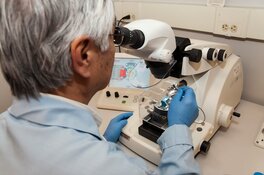The Life Sciences Report: Some experts have said that the intervertebral disc space is a hostile environment. Why?
Silviu Itescu: The intervertebral disc space is a hostile environment primarily because of the lack of direct blood and nutrient supply. Any nutrients to support the relatively low number of cells in the disc must diffuse from the adjacent vertebral bodies, above and below, through the cartilaginous endplates and into the disc. This low-nutrient environment becomes even more hostile as the disc degenerates. As a disc degenerates, the end plates of the vertebrae become less porous, further reducing the supply of nutrients to the disc. Because of the relatively low numbers of cells, the disc has a limited capacity for repair and self-regeneration. All of the degenerative changes together reduce the capacity of cells to repair the disc or even to produce the water-retaining proteoglycans in the nucleus of the disc that cushion compression forces in the spine of the upright human.
TLSR: What is an acceptable endpoint for a degenerative disc disease (DDD) trial?
SI: Patients seek treatment for back pain due to the pain itself, and the impact of that pain on their quality of life. Therefore the FDA has typically requested endpoints that reflect clinically meaningful improvement in pain and/or function.
TLSR: Do Mesoblast's mesenchymal precursor cells (MPCs) durably engraft after they are injected into the disc, or do they act in more of a druglike or paracrine fashion, and then leave the region?
SI: We do not believe that the MPCs integrate into the patient's tissue. In other therapeutic areas, we have seen our cells persist in the body for a few weeks to several months, but we have not specifically studied their persistence in the disc. We believe that once our cells are injected into the disc, they create a pro-regenerative environment in the disc that starts the regenerative cascade and positively influences the native cells to continue the regeneration of the disc. This is why we see continued regeneration and improvement over time, even after we believe our cells are no longer present.
TLSR: Are the cells administered to the patient in the same manner as a corticosteroid or other drug injection? Describe the procedure for me.
Read Analyst Jason Kolbert's Insights on Investing in the Cell Therapy Space
SI: Delivering the cells is relatively simple and quick, not too dissimilar to an epidural steroid injection. The procedure is performed in a fluoroscopy suite with the patient placed face down on the procedure table. The patients can have light sedation or local anesthesia, depending upon surgeon and patient preference. Under fluoroscopic guidance, a needle is placed into the center of the disc, the nucleus pulposus. The MPCs, which are cryopreserved in the vapor phase of liquid nitrogen, are thawed and mixed with a carrier material, hyaluronic acid, in a 1:1 ratio. The mixture is placed in a pressure manometer syringe to ensure that the injection does not increase the pressure in the disc and cause further damage. Approximately 2mL of the cell mixture is slowly injected into the center of disc. The needle is removed to complete the procedure. The patient may be observed for a short time before being released. The entire procedure typically takes less than 20 minutes.
TLSR: This procedure is going to cost much more than a corticosteroid injection. How do you envision that payers will respond to cell therapy in DDD?
SI: Typically, epidural steroids are not highly effective for treating chronic back pain. While some patients may receive some temporary pain relief—6 to 12 weeks—from the effect of a steroid injection, the benefit becomes less and less over time with regard to pain reduction, and the duration of relief decreases with each round of epidural steroid injections.
TLSR: Thank you, Silviu.
MW: Thank you.
Silviu Itescu is the founder, CEO, and managing director of Mesoblast Ltd.
DISCLOSURE:
1) George Mack conducted this interview for The Life Sciences Report and provides services to The Life Sciences Report as an independent contractor. He or his family own shares of the company mentioned in this interview: None.
2) Mesoblast Ltd. had final approval of the content and is wholly responsible for the validity of the statements. Opinions expressed are the opinions of Mesoblast Ltd. and not Streetwise Reports or The Life Sciences Report or its officers.
3) The interview does not constitute investment advice. Each reader is encouraged to consult with his or her individual financial professional and any action a reader takes as a result of information presented here is his or her own responsibility. By opening this page, each reader accepts and agrees to Streetwise Reports' terms of use and full legal disclaimer.
4) From time to time, Streetwise Reports LLC and its directors, officers, employees or members of their families, as well as persons interviewed for articles and interviews on the site, may have a long or short position in securities mentioned and may make purchases and/or sales of those securities in the open market or otherwise.









































